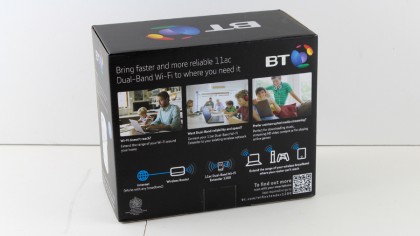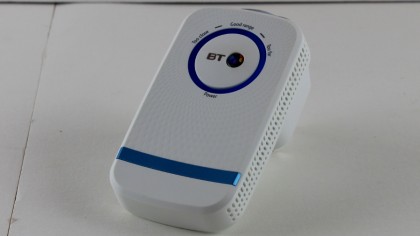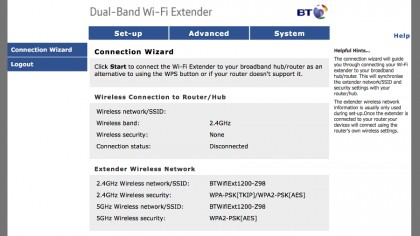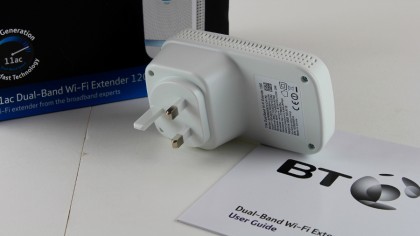TechRadar Verdict
Compact and generally easy to set up, this BT gadget is useful in the right situation – though in our case, we found its performance disappointing.
Pros
- +
Mostly easy to set up
- +
Front LED indicator for signal strength
- +
Low profile, small device
Cons
- -
Not particularly fast
- -
In some situations, there are superior solutions
Why you can trust TechRadar
The term 'Wi-Fi notspot' is fairly self-explanatory – it's an area in a building where, for whatever reason, you just can't get a decent wireless signal, something most of us have surely experienced at some point. There are numerous ways to solve this problem and one of these is by using a wireless bridge or Wi-Fi extender such as the BT Dual-Band Wi-Fi Extender 1200 (which is priced at £50).
It can extend any existing wireless signal, regardless of the router model or wireless standards it supports. It outputs dual frequency bands, including 2.4GHz 802.11 b/g/n as well as much faster 5GHz 802.11ac.

The device plugs into a power socket and for optimal performance is best placed halfway between your router and the area where you're trying to improve Wi-Fi connectivity. It has a single Ethernet port on the top and a WPS button with an LED ring on the front which indicates power status and signal strength.
By indicating 'Too Close', 'Too Far' and 'Good Range' right on the front, it provides visual feedback for how well you've positioned it, so it can be moved to a better location if needed.

Setup
BT has made it as simple as possible to install, with a straightforward installation procedure and very clear instructions in the manual, with a well-described three-step process. It's obvious that BT has made every effort to ensure installation can be performed by anyone with just a modicum of technical ability.
You can set it up by pressing the WPS button if you like, or log in to the extender's on-board software, using the passwords on the back of the manual, and configure it manually. The on-screen connection wizard scans the area for nearby wireless networks, letting you pick the correct one for your router.

I ran into a small issue at this point, since after selecting the existing wireless network for a Virgin Media Superhub, the BT software wizard expected a 5-digit WEP passcode, when the network was using a 7-digit WPA2 passcode. It was easily solved by selecting the correct security type in the Advanced connection settings though.
With the extender connected to your wireless network, it then copies all the settings for it, and creates two new wireless networks, one with EXT2 appended to the name on the 2.4GHz frequency, and another with EXT5 for 5GHz 802.11ac wireless. The wireless key remains the same as for your main router and it uses the same DHCP server, so there are no issues with IP address resolution or seeing other devices on the network.
There's a switch on the top of the device to adjust the frequency it uses to connect to the main router, either 2.4GHz or 5GHz. For optimal range, you'll want to keep the connection between the extender and router at 2.4GHz, with your client connected at 2.4GHz, while in a smaller area, keeping both client and extender on 5GHz should give the best speed.

Performance
With the main router upstairs, lying in a corner, I moved to the opposite end of the house, to my living room where bandwidth is sometimes limited. A quick test using the Mac software Wi-Fi perf showed a connection speed of around 35Mb/sec without using the extender.
I then plugged the extender into a spare power socket in the hallway, with the front LED indicating good range. I connected to it with my laptop and performance dropped to just 25Mb/sec. It seemed to make no difference with the switch on top set to 5GHz, or when connecting to the 5GHz network. Performance was consistently worse.
It's obvious I wasn't using it correctly. 35Mb/sec isn't great, but it's hardly a speed that would prevent using my devices, so in this case, it was better to just use the router's main wireless network, even though I was hoping for better speeds when using the extender.
I then moved to around 15m away from the extender and tested speeds from there. Performance dropped to around 10Mb/sec, and maintained a solid connection. But even at this range, my router could still deliver roughly the same speeds, even though it was further away.
